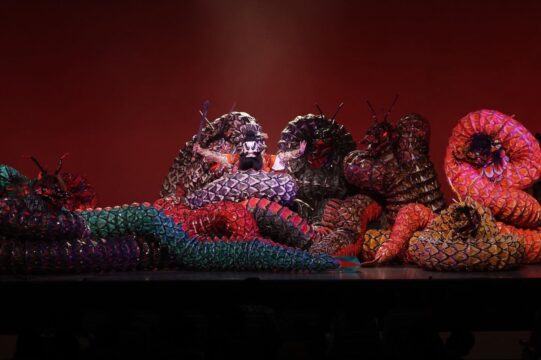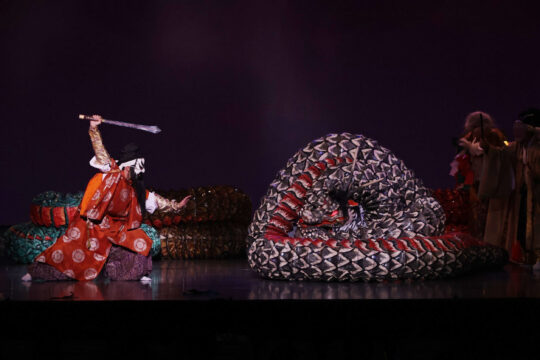The Great Serpent Descends: Iwami Kagura. A traditional art inherited and dedicated to the gods.
Iwami Kagura was born in Hamada City, Shimane Prefecture, where it has cultivated its own unique culture, shaped by a landscape of mountains and sea that feels like stepping back in time. It’s a tradition that has evolved with the times while preserving its roots.
In this performance, you’ll see a collection of powerful and profound dances, including Orochi, a dance synonymous with Iwami Kagura itself. The intricate yet powerful movements, vivid costumes, and expressive masks are sure to captivate you.
Please take this opportunity to experience the charm of Iwami Kagura up close and personal.


Iwami Kagura is a traditional performing art of the Iwami region in western Shimane Prefecture.
The exact origins of Iwami Kagura are unknown, as its history is quite old. However, its repertoire expanded greatly in the late Edo period when a new interest in Japanese classics led to the inclusion of myths from the Kojiki and Nihonshoki.
Originally a Shinto ritual performed by priests to appease the gods, Iwami Kagura was passed down to the local people and evolved into a folk art. This happened after the government banned priests from performing during the Meiji era.
A major highlight of Iwami Kagura is its powerful rhythm. The dynamic musical accompaniment—featuring large and small drums, cymbals, and flutes—seems to embody the spirit of the Iwami people, drawing the audience deep into its mythological world. Its unique lyrics are also a key feature. The solemn, classical language is interwoven with simple dialect and poetic folk song-like sentiments, giving Iwami Kagura its distinct flavor.
In essence, Iwami Kagura is a quintessential traditional performing art of the Iwami region. It captivates audiences with its powerful dances, music, and heartfelt words, all set within the world of ancient mythology.
▼Details of the performance can be found below.▼
| Friday, August 29 Evening Session (includes dinner) | [Time] 18:30-20:40 (doors open 18:00) [admission fee] Adults ¥11,000 Junior high/High school students ¥6,000 Elementary school students ¥4,000 Toddlers (4-6 years) ¥3,000 [Contents] Kagura performance + meal (19:10-19:50) with 1 drink. [Programmes] ①Benkei②Orochi 『Benkei』 On a beautiful moonlit night during the Heian period, Benkei, a powerful warrior of the Western Pagoda, confronted the graceful young Ushiwakamaru on Kyoto’s Gojo Bridge. Benkei, seeking to claim the magnificent sword carried by Ushiwakamaru, challenged him to a duel. Despite Benkei’s exceptional size and strength, Ushiwakamaru, who was playing a refined flute, skillfully dodged his every blow. Exhausted, Benkei finally surrendered to the young boy. This young hero, who learned the art of war from a great tengu on Mount Kurama, would go on to become the legendary Minamoto no Yoshitsune. Benkei, in turn, became Yoshitsune’s loyal retainer for the rest of his life. This kagura adaptation immortalizes their famous first meeting. Characters: Benkei, Ushiwakamaru 『Orochi』 When Susano-o no Mikoto approached the Hii River in the Land of Izumo, he met an elderly couple whose daughter was about to be eaten by a giant serpent. Susano-o no Mikoto had the old couple make strong sake, which the serpent drank. He then killed the drunken serpent and rescued Princess Inada. The sword that came out of the serpent’s tail is now enshrined at Atsuta Shrine as the Sword of Ame no Murakumo (later the Sword of Kusanagi), one of the Three Sacred Treasures. Characters: Susano-o no Mikoto, Ashinazuchi, Tenazuchi, Kushinadahime, Yamata-no-orochi ★After the performance, there will be a photo session with the kagura actors. (Participation requires an admission fee and is limited to those who win the lottery on the day of the performance.) |
| Saturday 30 August Lunchtime | [Time] 10:30-12:10 (doors open 10:00) [admission fee] Adults 3,300 yen, Junior high/High school students 3,300 yen, Elementary school students 2,200 yen, Toddlers (4-6 years) 1,100 yen. [Contents] Kagura performance [Programmes] ①Ebisu②Jinrin③Orochi 『Ebisu』 This performance is about Ebisu, Yae Kotoshironushi no Mikoto, the first child of Okuninushi no Mikoto and the deity of the Miho Shrine. A traveller pays a visit to Miho Shrine on his pilgrimage to Izumo-taisha, and while asking a courtesan about the history of the shrine, Ebisu appears before his eyes, and he fishes out a sea bream to express his long life and happiness. Characters = Ebisu, Taijin 『Jinrin』 Tarashinakatsuhiko, the 14th Emperor of Japan, intercepted an army of tens of thousands of cavalrymen attacking Japan from a foreign land. He was told that among them was an evil demon called Jinrin, who had wings and flew around on a black cloud, harming the people. Characters =Tarashinakatsuhiko (Tarashinakatsuhiko), later Emperor Nakai, Takamaro (Takamaro), Jinrin (Jinrin) white and red demons. 『Orochi』 When Susano-o no Mikoto approached the Hii River in the Land of Izumo, he met an elderly couple whose daughter was about to be eaten by a giant serpent. Susano-o no Mikoto had the old couple make strong sake, which the serpent drank. He then killed the drunken serpent and rescued Princess Inada. The sword that came out of the serpent’s tail is now enshrined at Atsuta Shrine as the Sword of Ame no Murakumo (later the Sword of Kusanagi), one of the Three Sacred Treasures. Characters = Susano-no-mikoto, Ashinazuchi, Tenazuchi, Kushinadahime, Yamata-no-orochi ★After the performance, there will be a photo session with the kagura. (Paying admission/picked by lottery on the day of the performance). |
| Venue | 4F Oriental Ballroom |
| Performers | Hamada Iwami Kagura Shachu Liaison Council |
| Organising | Oriental Hotel Hiroshima |
| Collaboration | Hamada City Tourism Association |
TEL +81 82-240-5111
Opening hours: 9:00-18:00
*Except Saturdays, Sundays and public holidays.


